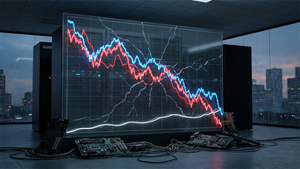Financial News
The Great Divide: Is the Market Offering a Dip or Signalling a Bear?

As November 25, 2025, unfolds, financial markets find themselves at a critical juncture, gripped by a pervasive debate that pits optimists against skeptics: are current market pullbacks merely a "Buy The Dip" opportunity, or do they herald the onset of a more protracted "Bear Market"? This question hangs heavy in the air, shaping investor sentiment and influencing strategic decisions across the globe. While robust corporate earnings and the tantalizing prospect of Federal Reserve rate cuts fuel bullish hopes, persistent inflation, a softening labor market, and geopolitical undercurrents cast long shadows, keeping the bear market thesis alive.
The immediate implications of this divide are palpable, manifesting in heightened market volatility and a stark divergence in sectoral performance. Technology and AI-driven investments continue to exhibit remarkable resilience, rewarding those who have bought into recent dips. However, traditional sectors face headwinds, suggesting a "K-shaped recovery" where fortunes diverge sharply. Investors are thus navigating a treacherous landscape, forced to discern between temporary corrections and systemic shifts, with the outcome poised to define portfolio performance in the coming months.
A Market in Flux: Unpacking the Current Financial Crossroads
The current market conditions, as of late 2025, present a complex mosaic of resilience and apprehension. The S&P 500 (SPX) has demonstrated remarkable gains throughout the year, up 12.5% year-to-date by mid-November, following strong returns in both 2023 and 2024. The Nasdaq Composite (IXIC) has been a particular standout, jumping 4.7% in October alone and boasting a 23.5% year-to-date gain, largely propelled by the relentless enthusiasm surrounding Artificial Intelligence (AI) investments. These figures often embolden the "Buy The Dip" contingent, who point to the historical tendency of the market to rebound after corrections, especially in a seemingly young bull market. Indeed, the Nasdaq 100 has made 2025 a banner year for dip-buyers.
However, beneath this veneer of growth, several underlying currents suggest caution. Consumer sentiment dipped in November 2025, reflecting persistent concerns over a weakening labor market and elevated prices. Inflation, as measured by the Consumer Price Index (CPI), accelerated to an annual rate of 2.9% in November, driven by housing and services, and remains stubbornly above the Federal Reserve's 2% target. Furthermore, the unemployment rate has gradually climbed, reaching 4.4% in September, the highest since October 2021, signaling a potential slowdown in economic momentum. These macroeconomic indicators provide considerable ammunition for those warning of an impending bear market, suggesting that the recent market strength might be a facade.
The timeline leading up to this moment has been marked by a series of Federal Reserve actions and reactions. After a period of aggressive rate hikes, the Fed reduced its policy rate by 100 basis points over the last four months of 2024, followed by a nine-month pause, and then resumed easing with a 25 basis point cut in September 2025. Markets are now pricing in a high probability (70-80%) of another rate cut in December 2025, largely due to concerns over the softening labor market. This dovish pivot from the Fed is a key player in current market optimism, with investors hoping that lower borrowing costs will provide a tailwind for corporate earnings and economic growth. However, if inflation proves more persistent than anticipated, or if the labor market doesn't weaken as sharply, the Fed might not meet these "lofty easing expectations," potentially triggering a significant market correction.
Key players in this ongoing debate include prominent analysts from major investment banks like Morgan Stanley (NYSE: MS), Goldman Sachs (NYSE: GS), and Deutsche Bank (NYSE: DB), who offer varying S&P 500 targets for 2025, generally leaning towards continued growth but acknowledging risks. Economists from institutions like S&P Global Ratings provide GDP and inflation forecasts, painting a picture of slowing but still positive economic growth. Initial market reactions to economic data releases, such as inflation figures or employment reports, have been swift and often volatile, reflecting the market's sensitivity to any signals that might tip the scales towards either a prolonged bull run or a downturn.
Corporate Fortunes in the Balance: Winners and Losers in a Divided Market
The prevailing market uncertainty creates a bifurcated landscape for public companies, where fortunes are inextricably linked to whether the current environment evolves into a sustained bull run or a prolonged downturn. As of November 25, 2025, the interplay of elevated interest rates, persistent inflation, moderating consumer spending, and the intense focus on Artificial Intelligence (AI) investments dictates which sectors and individual companies are poised to thrive or struggle.
In a "Buy The Dip" scenario, where market corrections are seen as temporary aberrations in an otherwise upward trajectory, Technology companies, particularly those at the forefront of AI, are expected to lead the charge. Firms specializing in enterprise AI software, semiconductor equipment, and cybersecurity stand to benefit immensely as AI transitions from speculative investment to tangible, revenue-generating applications. Giants like NVIDIA (NASDAQ: NVDA), Microsoft (NASDAQ: MSFT), and Apple (NASDAQ: AAPL), deeply integrating AI into their core offerings, are prime examples of companies that would see significant rebounds. The Financials sector is also positioned for a strong recovery, viewed as undervalued and poised to benefit from superior earnings growth, a potentially deregulatory environment, and a resurgence in merger and acquisition activity. Banks, in particular, could see boosted net interest income from elevated interest rates. Industrials are set to gain from significant government spending on infrastructure and a revitalization of manufacturing, while the Energy sector, driven by global demand, offers promising opportunities in integrated oil majors and renewable energy storage. Select growth stocks with proven track records, such as Eli Lilly (NYSE: LLY) in pharmaceuticals or ServiceNow (NYSE: NOW) in software, could also experience substantial rebounds.
Conversely, a "Bear Market" scenario, characterized by a sustained downturn, would see investors flock to defensive sectors. Consumer Staples companies, providing essential goods like food and household necessities, offer stability and consistent dividends, making them attractive safe havens. Firms like Bunge Global SA (NYSE: BG) and Archer-Daniels-Midland Company (NYSE: ADM) exemplify this resilience. Utilities, supplying essential services such as water and electricity, are largely impervious to economic cycles, offering predictable cash flows. Healthcare, due to its essential nature, also tends to be resilient, encompassing pharmaceuticals and medical devices. Furthermore, Defense Stocks, with their predictable government contracts and often healthy dividends, from companies like Lockheed Martin (NYSE: LMT) and Northrop Grumman (NYSE: NOC), tend to outperform in turbulent times. In such an environment, Bonds could also see a resurgence as investors seek fixed-income stability and higher yields from new issuances.
On the losing side of a bear market, highly valued Technology stocks, especially those perceived to be part of an "AI Bubble," would be extremely vulnerable. Overinflated valuations and a failure to translate AI investments into commensurate revenue growth would expose these companies to sharp declines. Consumer Discretionary companies, which sell non-essential goods and services (e.g., luxury items, automobiles, restaurants), would suffer significantly as consumers tighten their belts due to higher interest rates and reduced purchasing power. Real Estate and Construction sectors are highly sensitive to interest rates, facing headwinds from increased mortgage costs and slower development projects. Similarly, Materials companies, which are capital-intensive, would see demand for raw materials decline during an economic contraction. Smaller companies generally face greater challenges in securing financing and enduring economic slowdowns, making them more susceptible to a downturn. The Cryptocurrency sector also faces unique vulnerabilities in a bear market, with many assets already trading at significant premiums amidst regulatory uncertainty.
The Broader Canvas: Understanding the Wider Significance
The ongoing debate between a "Buy The Dip" opportunity and an impending "Bear Market" is more than just a short-term market fluctuation; it represents a critical inflection point with far-reaching implications for broader industry trends, competitive landscapes, regulatory frameworks, and even draws parallels to historical economic cycles. As of November 25, 2025, several overarching themes underscore the wider significance of this market crossroads.
One of the most prominent broader industry trends is the continued, yet increasingly scrutinized, dominance of Artificial Intelligence (AI). While AI has fueled significant market gains, particularly in the tech sector, the discussion around an "AI-fueled stock market bubble" is intensifying. The outcome of the current market uncertainty will largely determine if AI continues its exponential growth trajectory, driving innovation and productivity across sectors, or if a significant correction tempers enthusiasm and re-evaluates valuations. This could lead to a shift from speculative AI investments to a greater emphasis on profitable, scalable AI applications, potentially benefiting companies with strong fundamentals and clear revenue models over those built on hype. The semiconductor industry, for example, is deeply intertwined with AI's fate, with companies like Taiwan Semiconductor Manufacturing Company (NYSE: TSM) and ASML Holding (NASDAQ: ASML) being critical enablers whose prospects hinge on sustained AI demand.
The potential ripple effects on competitors and partners are substantial. If the "Buy The Dip" thesis holds, it could reinforce the market leadership of established tech giants and innovative AI players, potentially widening the gap between them and smaller, less capitalized competitors. Conversely, a bear market could trigger a flight to quality, benefiting larger, more financially stable companies while severely challenging smaller, growth-oriented firms, especially those reliant on venture capital or high-interest debt. Supply chains, already strained by geopolitical tensions and protectionist policies, would face further disruption. For instance, increased tariffs, which have climbed to an effective U.S. rate of about 17% in 2025, could exacerbate costs for import-reliant sectors like automotive and consumer goods, affecting manufacturers and retailers globally.
Regulatory and policy implications are also significant. A prolonged downturn could prompt governments and central banks to re-evaluate monetary and fiscal policies. The Federal Reserve's current inclination towards rate cuts, driven by labor market concerns, might accelerate if bear market signals strengthen, potentially leading to more aggressive easing measures. Conversely, if inflation remains sticky, the Fed might face a difficult balancing act, risking a deeper recession if it continues to hike or maintain high rates. There could also be increased regulatory scrutiny on the tech sector, particularly concerning AI's ethical implications and market concentration, especially if an "AI bubble" bursts. International trade policies, influenced by ongoing geopolitical tensions, will continue to impact global supply chains and corporate profitability.
Historically, the current situation draws parallels to periods of economic uncertainty following rapid technological advancements or periods of elevated inflation. The dot-com bubble burst of the early 2000s serves as a cautionary tale for overvalued tech stocks, while the stagflation of the 1970s highlights the challenges of persistent inflation alongside slowing growth. However, direct comparisons are always imperfect. Today's market benefits from greater transparency, more sophisticated financial instruments, and the unprecedented integration of AI, which could either mitigate or amplify traditional market dynamics. The resilience shown by the S&P 500 and Nasdaq throughout 2025, despite mixed signals, suggests a market that has learned from past downturns, yet the underlying economic vulnerabilities cannot be ignored.
The Path Forward: Navigating Uncertainty and Opportunity
Looking ahead, the market stands at a crossroads, with short-term volatility giving way to potentially defining long-term trends. In the short term, investors should brace for continued market swings as the "Buy The Dip" and "Bear Market" narratives battle for dominance. The immediate focus will be on upcoming economic data releases, particularly inflation figures and labor market reports, and the Federal Reserve's December 2025 meeting, where a highly anticipated rate cut decision will heavily influence sentiment. Any deviation from current expectations regarding monetary policy could trigger significant market reactions. Sectoral divergence is likely to persist, with a continued emphasis on discerning value and growth opportunities within specific industries rather than broad market bets.
In the long term, the market's trajectory will largely depend on the resolution of several key macroeconomic factors. If inflation moderates sustainably towards the Federal Reserve's 2% target, and the labor market stabilizes without a severe contraction, a "Buy The Dip" scenario could evolve into a sustained bull market, albeit potentially at a slower pace than the rapid growth seen in 2023-2024. This would likely be driven by continued innovation in AI, robust corporate earnings, and a more predictable interest rate environment. Companies that have strategically invested in AI infrastructure and applications, and those with strong balance sheets capable of weathering economic headwinds, will be best positioned for long-term growth.
Conversely, if inflation proves more stubborn, forcing the Fed to maintain higher rates or even resume tightening, or if the labor market deteriorates significantly, a bear market becomes a more probable outcome. This would necessitate strategic pivots for many companies, focusing on cost-cutting, efficiency gains, and shoring up balance sheets. Defensive sectors, such as Consumer Staples and Utilities, would likely continue to outperform, offering refuge for capital. Market opportunities in such a scenario might shift towards value investing, dividend-paying stocks, and potentially distressed assets, while challenges would include sustained pressure on growth stocks and sectors sensitive to consumer discretionary spending.
Potential scenarios range from a "soft landing" where the economy avoids a recession and inflation gradually subsides, leading to a mild "Buy The Dip" rebound, to a more severe "hard landing" characterized by recession and a prolonged bear market. A "no landing" scenario, where inflation remains elevated and growth persists, could also lead to continued volatility and a challenging environment for both equities and bonds. Investors should consider building diversified portfolios that can withstand various outcomes, focusing on companies with strong competitive advantages, resilient business models, and attractive valuations, rather than chasing fleeting trends.
The Enduring Debate: A Market Poised for Transformation
As of November 25, 2025, the financial markets are embroiled in a fundamental debate, a defining characteristic of this period of economic transition. The question of whether current pullbacks represent a "Buy The Dip" opportunity or the nascent stages of a "Bear Market" is not merely academic; it has profound implications for investment strategies, corporate performance, and the broader economic landscape. The key takeaways from this ongoing discussion highlight a market grappling with contradictory signals: strong corporate earnings and AI-driven enthusiasm on one side, juxtaposed with persistent inflation, a softening labor market, and elevated interest rates on the other.
Moving forward, the market's trajectory will be heavily influenced by the Federal Reserve's monetary policy decisions, the path of inflation, and the resilience of consumer spending. While the "risk-on" sentiment, fueled by hopes of rate cuts, has provided significant support, the underlying vulnerabilities cannot be ignored. The "K-shaped recovery" observed in recent months, where technology and AI sectors thrive while traditional industries face headwinds, underscores the need for selective and discerning investment approaches. Passive index investing might be less effective in an environment demanding careful stock picking and sector-specific analysis.
The lasting impact of this period will likely be a more mature and scrutinized approach to growth, particularly within the high-flying AI sector. Investors will increasingly demand tangible revenue and profit generation from AI investments, moving beyond mere hype. The market may also see a re-evaluation of traditional valuation metrics in light of persistent inflation and higher interest rates. Ultimately, the current uncertainty serves as a powerful reminder of the cyclical nature of markets and the importance of disciplined, long-term investing principles.
What investors should watch for in the coming months includes any significant shifts in inflation data, particularly core CPI and PCE, further developments in the labor market (unemployment rate, wage growth), and the Federal Reserve's rhetoric and actions regarding interest rates. Geopolitical events and their impact on global supply chains and energy prices will also remain crucial factors. The performance of bellwether technology companies, especially those heavily invested in AI, will serve as a barometer for market sentiment. Above all, adaptability and a willingness to re-evaluate investment theses in light of new information will be paramount for navigating this transformative period.
This content is intended for informational purposes only and is not financial advice
More News
View More




Recent Quotes
View More
Quotes delayed at least 20 minutes.
By accessing this page, you agree to the Privacy Policy and Terms Of Service.



